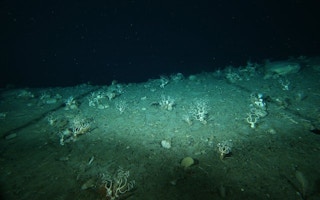US and British researchers may have identified the fingerprint of global warming in one of the darkest, coldest, most mysterious places on the planet. Four thousand metres below the sea surface, at the bottom of the north-east Pacific abyss, they have found changes in the food supply to some of the planet’s least known creatures. And these changes track changes to temperatures at the surface.
Kenneth Smith of the Monterey Bay Aquarium Research Institute and colleagues from the University of Southampton in the UK, and the Scripps Institution of Oceanography in San Diego, report in the Proceedings of the National Academy of Sciences on a 24-year exploration of one of life’s deepest puzzles.
The research is important because it provides yet another indicator of the carbon cycle at work; it is important because it provides another level of understanding of the climate system; and because it provides yet another way to check on global warming.
The last aspect is probably the least significant, if only because the period of observation is so brief, the study is confined to only one site, and the conditions for observation so difficult. But it offers a neat demonstration of how science is done.
Life at depth
In 1989, at an ocean point known as Station M, researchers began collecting biological material as it sank to the depths. The traps were roughly 600 metres and 50 metres above the ocean floor, and the catch was simple enough: dead plankton, fish excrement, mineral dusts and the carcases of tiny creatures will all ultimately sink and settle on the sea bottom. Nature wastes nothing: this rotting material provides food for impoverished communities scrabbling for survival at the ocean bottom, so far from the Sun’s light.
When the food supply fails, such communities have a hard time. A sudden periodic bloom of plankton at the surface – itself an indicator of changing seasons and conditions – might guarantee a period of plenty, with enough left over to help some creatures survive the next famine.
The research team sank a time-lapse camera that provided hourly snapshots of change over a 20 square metre segment of the ocean floor. They checked seasonal changes to the sediment and the bottom water by lowering an instrument called a free vehicle grab respirometer to take samples, and in 2011, they started using an autonomous deep sea vehicle called a benthic rover to take high resolution pictures of the ocean bottom. They also used satellite imagery to measure changes in chlorophyll — the agency of photosynthesis — at the ocean surface
Warming pointers?
What they found was a distinct seasonal pattern, as upwelling brought fresh nutrients to the California Current, and phytoplankton – the sea’s primary food source – started to bloom again. They also started noticing peaks in organic particulate carbon, with the highest ever recorded in 2011, and another huge surge in 2012.
This could be because winds above the surface are increasing, leading to more upwelling and therefore more nutrients to help the algae bloom. The researchers believe that these peaks can be linked to global warming, but the evidence so far comes from only one research station. More convincing answers could emerge from a study of other such monitoring stations.
More than 60% of the planet is deep ocean floor: what happens down there could answer questions about the traffic of carbon from the air to the primeval ooze. Will carbon dioxide go on building up in the atmosphere? Or will green things take advantage of that carbon, use it and ultimately bury increasing quantities of it, to limit the rate of global warming?
“Carbon remineralisation and sequestration in the deep ocean are major unknown components in attempts to realistically model the global carbon cycle,” the authors conclude. “Long time-series studies, such as the 24-year continuing study at Station M, remain the key mechanisms to resolving such carbon-cycle questions.”










